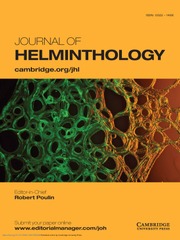No CrossRef data available.
Article contents
Antioxidant and anti-inflammatory effects of ellagic acid as a new therapy for Trichinella spiralis infection
Published online by Cambridge University Press: 10 December 2024
Abstract
Trichinellosis is a widespread food-borne zoonosis, causing mild to severe illness in humans with potential fatality. Its treatment remains challenging due to the side effects and limited efficacy of specific drugs. Therefore, the current study was conducted to assess the therapeutic effects of ellagic acid (EA) alone and combined with albendazole against trichinellosis and its biochemical and pathological alterations in mice. Mice were divided into two main groups: G1 and G2 for the intestinal and muscular phases, respectively. Then each group was subdivided into five subgroups: (a) non-infected control, (b) infected control non-treated, (c) infected and treated with EA, (d) infected and treated with albendazole, and (e) infected and treated with a combination of both. Parasitological, biochemical, and histopathological studies were used to evaluate the therapeutic outcomes. Treatment with EA resulted in a significant reduction of the mean counts of intestinal adult worms and muscular larvae compared to the infected control. EA improved oxidative stress as it reduced nitric oxide and increased catalase activities in intestinal and muscular tissues. Additionally, it alleviated the inflammatory response, as evidenced by downregulating IL-6 and increasing IL-10 expressions in tissues. Furthermore, it improved liver functions and ameliorated the pathological alterations induced by trichinellosis. The best results were detected in combination treatments that indicated synergistic effects between EA and albendazole. In conclusion, EA can be used as an anti-inflammatory and antioxidant with a promising anti-parasitic impact against trichinellosis.
- Type
- Research Paper
- Information
- Copyright
- © The Author(s), 2024. Published by Cambridge University Press


